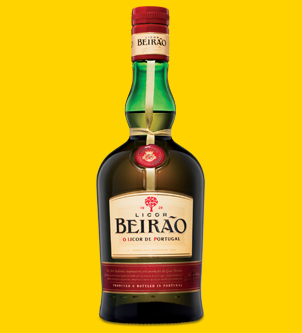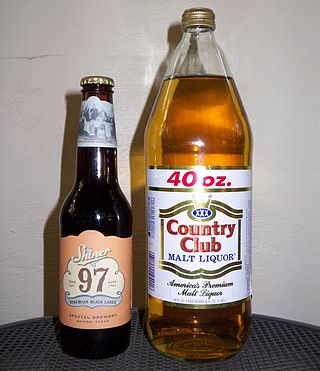Related Research Articles

An alcopop is any of certain mixed alcoholic beverages with relatively low alcohol content, including:
- Malt beverages to which various fruit juices or other flavorings have been added
- Wine coolers: beverages containing wine to which ingredients such as fruit juice or other flavorings have been added
- Mixed drinks containing distilled alcohol and sweet liquids such as fruit juices or other flavourings

A drink or beverage is a liquid intended for human consumption. In addition to their basic function of satisfying thirst, drinks play important roles in human culture. Common types of drinks include plain drinking water, milk, juice, smoothies and soft drinks. Traditionally warm beverages include coffee, tea, and hot chocolate. Caffeinated drinks that contain the stimulant caffeine have a long history.

Gin is a distilled alcoholic drink flavoured with juniper berries and other botanical ingredients.

A liqueur is an alcoholic drink composed of spirits and additional flavorings such as sugar, fruits, herbs, and spices. Often served with or after dessert, they are typically heavily sweetened and un-aged beyond a resting period during production, when necessary, for their flavors to mingle.

Low-alcohol beer is beer with little or no alcohol by volume that aims to reproduce the taste of beer while eliminating or reducing the inebriating effect, carbohydrates, and calories of regular alcoholic brews. Low-alcohol beers can come in different beer styles such as lagers, stouts, and ales. Low-alcohol beer is also known as light beer, non-alcoholic beer, small beer, small ale, or near-beer.

Whisky or whiskey is a type of liquor made from fermented grain mash. Various grains are used for different varieties, including barley, corn, rye, and wheat. Whisky is typically aged in wooden casks, which are typically made of charred white oak. Uncharred white oak casks previously used for the aging of port, rum or sherry are also sometimes used.

Smirnoff is a brand of vodka owned and produced by the British company Diageo. The Smirnoff brand began with a vodka distillery founded in Moscow by Pyotr Arsenievich Smirnov (1831–1898). It is distributed in 130 countries, and manufactured locally in some, as in Illinois in the United States.
A wine cooler is an alcoholic beverage made from wine and fruit juice, often in combination with a carbonated beverage and sugar.

Alcohol by volume is a standard measure of how much alcohol is contained in a given volume of an alcoholic beverage. It is defined as the number of millilitres (mL) of pure ethanol present in 100 mL of solution at 20 °C (68 °F). The number of millilitres of pure ethanol is the mass of the ethanol divided by its density at 20 °C (68 °F), which is 0.78945 g/mL. The alc/vol standard is used worldwide. The International Organization of Legal Metrology has tables of density of water–ethanol mixtures at different concentrations and temperatures.

Malt liquor is a type of mass market beer with high alcohol content, most closely associated with North America. Legally, it often includes any alcoholic beverage with 5% or more alcohol by volume made with malted barley. In common usage, it refers to beers of high alcohol content, generally above 6%, which are made with ingredients and processes resembling those for American-style lagers.

A standard drink or unit of alcohol is a measure of alcohol consumption representing a fixed amount of pure alcohol. The notion is used in relation to recommendations about alcohol consumption and its relative risks to health. It helps to educate alcohol users. A hypothetical alcoholic beverage sized to one standard drink varies in volume depending on the alcohol concentration of the beverage, but it always contains the same amount of alcohol and therefore produces the same amount of drunkenness. Many government health guidelines specify low to high risk amounts in units of grams of pure alcohol per day, week, or single occasion. These government guidelines often illustrate these amounts as standard drinks of various beverages, with their serving sizes indicated. Although used for the same purpose, the definition of a standard drink varies from country to country.

Liquor is an alcoholic drink produced by the distillation of grains, fruits, vegetables, or sugar that have already gone through alcoholic fermentation. Other terms for liquor include: spirit, distilled beverage, booze, spirituous liquor or hard liquor. The distillation process concentrates the liquid to increase its alcohol by volume. As liquors contain significantly more alcohol (ethanol) than other alcoholic drinks, they are considered "harder." In North America, the term hard liquor is sometimes used to distinguish distilled alcoholic drinks from non-distilled ones, whereas the term spirits is more commonly used in the UK. Some examples of liquors include vodka, rum, gin, and tequila. Liquors are often aged in barrels, such as for the production of brandy and whiskey, or are infused with flavorings to form flavored liquors, such as absinthe.
Rectified spirit, also known as neutral spirits, rectified alcohol or ethyl alcohol of agricultural origin, is highly concentrated ethanol that has been purified by means of repeated distillation in a process called rectification. In some countries, denatured alcohol or denatured rectified spirit may commonly be available as "rectified spirit", because in some countries the retail sale of rectified alcohol in its non-denatured form is prohibited.
Alcoholic beverage control states, generally called control states, less often ABC states, are 17 states in the United States that have state monopoly over the wholesaling or retailing of some or all categories of alcoholic beverages, such as beer, wine, and distilled spirits.

Flavored fortified wines or tonic wines are inexpensive fortified wines that typically have an alcohol content between 13% and 20% alcohol by volume (ABV). They are made from various fruits with added sugar, artificial flavor, and artificial color.

Alcoholic drinks in Sweden are as common as in most of the Western world. Sweden is historically part of the vodka belt, with high consumption of distilled drinks and binge drinking, but during the later half of the 20th century, habits are more harmonized with western Europe, with increasing popularity of wine and weekday drinking. Wine is now also grown and produced in several parts of Sweden and the southernmost region of Skåne is turning into a hub experiencing a strong growth in number of active vineyards.

An alcoholic beverage is a drink that contains ethanol, a type of alcohol and is produced by fermentation of grains, fruits, or other sources of sugar. The consumption of alcoholic drinks, often referred to as "drinking", plays an important social role in many cultures. Alcoholic drinks are typically divided into three classes—beers, wines, and spirits—and typically their alcohol content is between 3% and 50%.

Alcohol laws are laws relating to manufacture, use, being under the influence of and sale of alcohol or alcoholic beverages. Common alcoholic beverages include beer, wine, (hard) cider, and distilled spirits. Definition of alcoholic beverage varies internationally, e.g., the United States defines an alcoholic beverage as "any beverage in liquid form which contains not less than one-half of one percent of alcohol by volume". Alcohol laws can restrict those who can produce alcohol, those who can buy it, when one can buy it, labelling and advertising, the types of alcoholic beverage that can be sold, where one can consume it, what activities are prohibited while intoxicated, and where one can buy it. In some cases, laws have even prohibited the use and sale of alcohol entirely.
A malt drink is a fermented drink in which the primary ingredient is the grain, or seed, of the barley plant, which has been allowed to sprout slightly in a traditional way called "malting" before it is processed.
References
- ↑ "What is meant by alcohol-free?". alcoholfree.co.uk. 14 May 2006. Retrieved 23 January 2020.
- ↑ "low alcohol wines". bottle barn.
- ↑ Oxford English Dictionary. Oxford, England: Oxford University Press. 1989.
- ↑ "Beverage Alcohol Labeling Requirements by Country". IARD.org. Retrieved 10 June 2016.
- ↑ "Sweden's alcohol-free drink label 'misleading'". Thelocal.se. 29 October 2012. Retrieved 5 February 2013.
- ↑ "fruc.org". fruc.org. Retrieved 10 April 2018.
- 1 2 Rollins, Cristin Eleanor; Finlay, William (2005). "Have You Heard the Trampling of the New Crusade?": Organizational Survival and the Woman's Christian Temperance Union. p. 53.
- ↑ "Beverage Alcohol Labeling Requirements by Country". Icap.org. Archived from the original on 21 February 2013. Retrieved 5 February 2013.
- ↑ "Nu må en alkoholfri øl indeholde mere alkohol". politiken.dk. 11 April 2014.
- ↑ "Alcohol Act".
- ↑ Porretta, S.; Donadini, G. (2008). "A Preference Study for No Alcohol Beer in Italy Using Quantitative Concept Analysis". Journal of the Institute of Brewing. 114 (4): 315–321. doi: 10.1002/j.2050-0416.2008.tb00775.x .
- ↑ "Alcohol-free products". Systembolaget.se. 11 March 2011. Archived from the original on 8 April 2013. Retrieved 5 February 2013.
- ↑ "Licensing Act 2003". legislation.gov.uk. Crown copyright.
- ↑ "酒税法".
- ↑ "ノンアルコール飲料". e-ヘルスネット 情報提供 (in Japanese). Retrieved 11 October 2020.
- ↑ "酒類の広告審査委員会 -自主基準 自主基準の遵守等-". www.rcaa.jp. Retrieved 11 October 2020.
- ↑ "Lov om omsetning av alkoholholdig drikk m.v. (alkoholloven)". lovdata.no.
- ↑ "State standard of non-alcoholic beverages". Euro-Asian Council for Standardization, Metrology and Certification.
- ↑ "Electronic Code of Federal Regulations". United States Government. See §7.65, paragraphs (e) and (f).